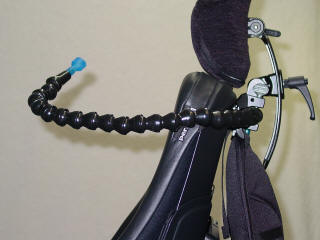Mealtime Partners, Inc.
Specializing in Assistive Dining and Drinking Equipment
February 2018 Independent Eating and Drinking Newsletter

|
February Topics:
|
||
|
Mealtime Partners Home Page Send a Comment or Suggestion |
|||
| Subscribe to Newsletters |
Dietary Fiber
This article is intended to provide some insight into the need for dietary fiber in our diets and some of the rich sources available. For many people, especially those who are unable to be active due to a disability, injury or age related health problem, avoiding constipation and gastric problems can be difficult. Eating foods rich in fiber can eliminate or lessen the need for laxatives and keep the digestive tract functioning well.
Dietary fiber is an essential component of what we eat if we are going to be healthy and have a body that functions well. It is recommended that men consume 30 to 38 grams of fiber, and women consume 21 to 25 grams, daily. There are two kinds of fiber that we eat: soluble and insoluble. Soluble fiber occurs inside plant cells and when it is mixed with water it forms a gel. The gel slows the emptying process of the stomach. This lowers blood glucose and cholesterol levels in the body in addition to making you feel full for a longer time after you eat. Insoluble fiber is found in the walls of plants. It adds bulk to the stool as it forms, and makes it softer and easier to process through the digestive tract. Consuming insoluble fiber helps avoid digestive issues like constipation and hemorrhoids. However, consuming too much insoluble fiber, if you are not used to it, can cause gas and bloating. If you are going to increase your intake, do so gradually.
Dietary fiber used to be referred to as roughage, and was generally thought to include all of the items we consumed that we do not digest. Many fruits, vegetables and legumes pass through the digestive tract relatively intact whereas fats, proteins, and carbohydrates are broken down and absorbed as they pass through the digestive tract. Processed fruits, vegetables, legumes and grains do not have as much dietary fiber as the natural product does. For example, canned peaches or green beans are lower in fiber than before they are canned. Whole grain bread or cereal provide a greater volume of fiber than their processed counterparts, such as white bread, because the outer husk of the grain is removed in the refining process.
There are problems with consuming enough dietary fiber to maintain a healthy body. Many people do not enjoy eating fruits and vegetables. Especially unpopular with the group of people who don’t like fruit and vegetables are dark green vegetables like kale and spinach, which contain lots of dietary fiber. To exacerbate this problem, many people find eating the peel or skin of fruit and vegetables difficult or unpleasant. For example, they may prefer to have a fresh apple peeled prior to eating it. Yet the skin of an apple provides the majority of the fiber and nutrition in the apple. Alternately, chewing up the skin or peel of fruit and vegetables can be difficult for many people. This is especially true for those who have problems with their teeth or have ill-fitting dentures.
Grains are easier to eat. They are commonly found in breakfast cereals and bread. It is important to read the bread and cereal labels to make sure that you are selecting whole grain whether it is in cereal or bread. Beans, peas and other legumes are also easier to eat and high in dietary fiber.
Oatmeal is a really good way to start the day. Not only does oatmeal feel like a “comfort” food, it is a powerhouse of goodness. It helps curb bad cholesterol, thus helping your heart health. If you are going to eat oatmeal you should be picky in selecting the product that you buy. Some of the instant oatmeal packets have lots of sugar and salt in them. To make instant oatmeal cook quickly, the oat groats (oat groats are the whole oat kernel), the oat groats are steamed and flaked. Regular, or rolled oats, are processed the same way as instant oats but the flakes are thicker and take longer to cook. Irish, or steel-cut oats, have the oat kernel cut up. It takes about 20-minutes to cook. Scottish oats are prepared by grinding the oat groats and take approximately an hour to cook. Regardless of your choice of type of oatmeal, eating it regularly has been linked to a 7% drop in LDL cholesterol.
The above information provides a basis for identifying sources of dietary fiber. The second article for this month’s newsletter will provide some insight into ways of preparing high fiber foods to make them easy to consume.
Regardless of the dietary content of the food that is served, the Mealtime Partner Dining System will be able able to serve it. Therefore, individuals who have difficulty feeding themselves are able to eat independently even if they consume a high fiber diet.
| An Easy Way to Stay Hydrated! | |
| For those people who are unable
to pick-up a cup or bottle to take a drink of water, dehydration
can easily happen. Having only a
sip of water, or even a couple of swallows, every hour or two
can easily lead to dehydration, especially during hot weather. A simple way of avoiding becoming thirsty, or worse, dehydrated, is to have a Hydration Backpack with Drinking Tube Positioning attached to your wheelchair or bed. This drinking system provides 70-ounces of water in a bladder that is attached to the back of a wheelchair, as pictured below. The bite valve, at the end of the drink tube can be positioned close to the user’s mouth so that they are able to take a sip of water whenever they choose. Taking regular sips of water throughout the day is an ideal way to stay hydrated! |
|
 |
 |
| Hydration Backpack with Drinking Tube Positioning (6559) |
Drink-Partner Drinking System for Slide-Track (6557) |
| There are two models of Hydration Backpack with Drink Tube Positioning: one will fit onto a standard manual wheelchair or bed rail (MtP Part No.6559), the other accommodates powered wheelchairs that have slide-track mounting rails (MtP Part No 6557). The only difference between them is the hardware for attaching to the chair (bed, etc.). The Hydration Backpack with Drink Tube Positioning is just one of the hands-free drinking systems available from Mealtime Partners. | |
| --------------------------------------------------------------------- | |
| For more information about all of the Mealtime Partners assistive drinking systems, click here. Or, to speak with a company representative, please call us at 800-996-8607. | |
Easy Ways of Consuming Dietary Fiber
The first article in this month’s newsletter described the importance of consuming enough fiber in our diet and described some good sources of fiber. For many people eating fiber rich food is either distasteful for them, or they have difficulty consuming fibrous foods because of poor dentition or weak oral motor muscles. This is a common problem for small children, individuals who have disabilities, and the elderly. However, this does not mean that food high in dietary fiber cannot be eaten and enjoyed.
Hot Cereals – There are several different breakfast cereals that are cooked and served hot. They are typically soft and pudding-like and easy to eat. However they are not equal in the amount of dietary fiber that they provide. Oatmeal is one of the best options, but rather than getting bored with having the same thing each morning you might experiment with quinoa or some of the other whole grain cereals that can be found in the supermarket. They can be served with or without toppings. If toppings like raisins or fresh fruit are added, they should be soft and require little or no chewing for those who have difficulties with chewing and swallowing; otherwise you will defeat the purpose of having this type of meal. Hot cereals make easy to eat meals that do not digest too quickly and, therefore, you remain feeling full after eating them.
Smoothies – Smoothies have become very popular in the last few years, but the term smoothie can describe a broad range of different drinks. To make a smoothie at home you will need a blender. However, not all blenders are strong enough to liquefy vegetables and harder fruits or frozen items. For a larger volume (enough to serve a family) a larger blender with a powerful motor will be needed. For those who have a family member who is fed through a feeding tube, a large blender is recommended as it will produce smoother drinks. Always add enough liquid (water, almond or coconut milk, etc.) to allow the blender to liquefy the fruit or vegetables in it.
The ingredients that you use for making a smoothie depend upon your likes and dislikes, and your dietary goals. In the case of consuming dietary fiber to avoid constipation, care should be taken to not overdo the fiber in the beginning. Also, if you increase dietary fiber to your diet, you should also consume more water. If you are not used to high volumes of fiber and you suddenly start consuming them, you might experience gas and bloating as well as constipation. Drink a small serving of smoothie every other day to start. Over time as your body becomes used to the fiber you can increase your volume. Smoothies are made up of a variety of fruits, vegetables, nuts, etc., and can be high in calories. Do not think of them as a drink, but rather consider them a replacement for a meal. There are numerous websites on the internet that offer various recipes for smoothies; also YouTube has many videos that demonstrate how to make a smoothie.
Prunes – Prunes have been a long standing treatment for constipation or to maintain regular bowels. Prunes are dried plums. As the plums become dehydrated, they become more concentrated. One plum has approximately 30 calories while the same sized plum when it is dehydrated is half the size and yet contains 23 calories. Five prunes contain the equivalent carbohydrates of 2 slices of bread! Prunes have a high content of both soluble and insoluble fiber and help food to process through the digestive tract. Prunes can be eaten whole, chopped or blended depending upon the oral motor skills of the person eating them.
For those individuals who are unable to eat or drink independently Mealtime Partners offers an array of hands-free drinking systems that are able to serve a smoothie, and also the Mealtime Partners Dining System that facilitates hands-free eating. More information can be found at www.mealtimepartners.com.
|
Did You Know? Did you know that researchers at Stanford University have recently completed a study to evaluate the impact of a healthy low-fat diet versus a healthy low-carbohydrate diet? The study included 609 overweight adults and was conducted over a year. The study concluded that there was no significant difference in weight loss regardless of the specific diet that was followed. The study did find that eating whole, unprocessed foods (fruit, vegetables, etc.), rather than counting calories, resulted in a similar weight loss. Christopher D. Gardner, PhD; John F. Trepanowski, PhD; Liana C. Del Gobbo, PhD; et al . |
To subscribe to the Mealtime Partners Newsletters, click here.
Mealtime Partners Website Navigation:
Home | Dining | Drinking | All Products | Ordering | Training | Calendar | FAQ | Newsletters | Contact
Please send comments and suggestions to newsletters@mealtimepartners.com
Copyright © Mealtime Partners, Inc. 2018
All rights reserved.